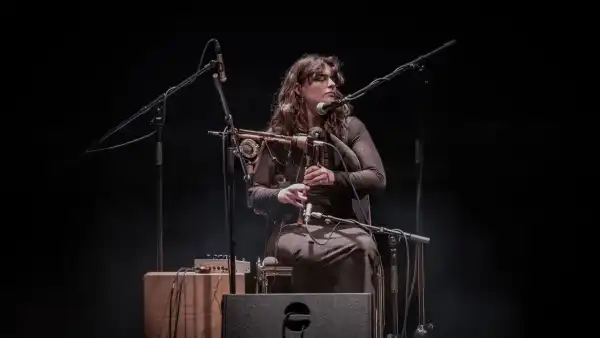
Save this storySave this storySave this storySave this story
One evening last spring, the audience at a bagpipe concert in Red Hook, Brooklyn, was divided into two distinct groups: those who knew little or nothing about bagpipes—the majority—and those who knew enough to have regimental patches from pipe bands across the Northeast adorned on their jackets. The latter category had mostly flocked to the event from Connecticut, where they lived. One of those jacket-wearers, a man with a septum piercing named Benjamin, spends his free time 3-D printing his own bagpipe drones—cylindrical tubes that produce continuous, harmonically rich vibrations from the instrument. When I asked him why he was doing this, he seemed confused. “Um, more drones?” he replied.
Everyone was there to see 27-year-old Brigde (pronounced “Breeche-ha”) Shaimboel, hailed from Scotland as one of the world’s most exciting and accomplished pipers. Shaimboel took to the stage in a magical outfit, complete with a navy tartan skirt, her raven hair pulled back into a half bun, and a perfectly calm expression framed by dark eyebrows. Beside her was Shahzad Ismaili, a renowned experimental jazz musician, holding a massive Moog synthesizer in his lap.
Every bagpipe performance begins with a shrill increase in speed as the bag fills with air, the buzzing strings activate with inhuman attention, like rabbit ears, and the sounds coalesce into a melody that begins to assert itself. Shaimbeul often lingers at a buzzing point for long, exploratory moments, savoring the many tones before introducing the melody. Her playing bears little resemblance to the predictable, nasal attacks most commonly associated with bagpipe music. Most people also instinctively picture the Great Highland bagpipes, a tartan-covered instrument used at funerals, consisting of a bladder the size of a large house cat and a system of pipes: one through which the player inflates with air from his lungs, three long buzzing strings dangling over his shoulder, and a chanter pipe on which the player’s fingers control the melody. Scheimbøl plays a lesser-known variant known as the Scottish smallpipe: a lighter, quieter instrument with a soft timbre created by bellows blown under the right elbow rather than the mouth, and a tight bundle of drones coiled around the chest. The instrument’s roots go back to at least the 15th century, but it was almost entirely forgotten by history, saved only by a popular revival in the 1980s. “These pipes were mostly lost in the depths of cupboards,” wrote the Lowland and Border Pipe Society’s journal in 1989, “or, as curiosities of the past, found themselves in museums where they sat silently gathering dust in display cases.”
Shaimbeul’s performance, with occasional bursts of Ismaili’s low, booming synths, filled the room like liquid. Her tunes, as she calls them, seemed dated in style but had the psychedelic, intellectual quality of an ambient set. Every now and then, she would address the microphone in her slow, deadpan accent. She introduced a song called “Pìobaireachd nan Eun,” or “Birds,” in which she sings in Scottish Gaelic. “Swans are very sacred creatures in Scottish folklore, thought to come from Tír na nÓg, or the land of eternity, and are cursed,” she explained to the crowd. “I was actually thinking the other day about how the royal family owns all the swans in the UK. It’s very interesting…” She trailed off as the crowd laughed. Her final performance ended with a nearly fifteen-minute hum—four notes that came naturally, rolling around inside their own harmonics, making the space vibrate. The rest of us, judging by the applause, could have enjoyed her performance for much longer.
Shymbøl grew up on the Isle of Skye, one of Scotland’s Inner Hebrides, in a family of artists, where her first language was Gaelic. Since switching from the Great Highland pipes to the small pipes as a teenager, she has won national folk competitions and released three solo albums (the latest, Sunwise, came out in June), as well as pilgrimages to places like Bulgaria, where other bagpipe traditions flourished; collaborated with indie singer-songwriter Caroline Polachek; and performed at a Dior show. In doing so, she has redefined the boundaries of her instrument. It’s easy to call
Sourse: newyorker.com